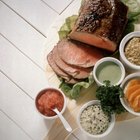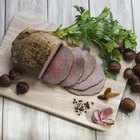Plateresca/iStock/GettyImages
English-cut roasts from the shoulder portion of the beef chuck are the toughest of the tough from that muscle group, and definitely one of the top three toughest cuts of beef you find in the market. But despite its toughness, it only takes a couple extra steps to finesse it to tenderness. First, you have to tie an English-cut roast, because it has an irregular shape that cooks unevenly. Next, season early to get a head start on softening connective tissue. Lastly, wait it out. It takes an English-cut roast four to five hours in a low-temperature oven to tenderize.
Take the English-cut roast out of the refrigerator about an hour before you want to cook it and season it heavily with kosher salt on all sides. Let it reach room temperature on a plate lined with paper towels.
Tie the roast with kitchen twine if it isn't tied already. First, tie the roast crosswise at 1-inch intervals, then tie the roast lengthwise at 1-inch intervals. Tie the twine tight enough to compress it but not cut into the meat. Snip off the twine trailing from the knots.
Heat the oven to 225 degrees Fahrenheit. Scrape off the excess kosher salt from the English roast.
Sear the English roast on all sides in an oiled cast-iron skillet, braising pan or Dutch oven over medium heat until golden brown, and set it aside.
Add about 1/4 to 1/2 pound of mirepoix, or diced carrots, onions and celery, to the pan and saute until browned, about 10 minutes.
Add a generous pouring of red wine to the pan and scrape it with a wooden spoon to deglaze it. Return the roast to the pan and pour enough warm stock in it to cover the English roast by about 1/4 inch.
Cover the pan with its lid and slide it into the oven. Braise the roast for two hours and turn it over in the dish, then add stock or water as needed to reach about halfway up the sides of the roast.
Braise the roast for another two hours and check its tenderness with a fork. Insert the fork between the twine and turn to see how easily it goes in and out. If you feel no resistance, take it out. If it still feels a bit tough, give it another hour in the oven and remove it.
Take the pan out of the oven and transfer the roast to a plate. Let the roast rest, with twine intact, for 30 minutes. In the meantime, you can simmer the pan juices until reduced by half and use it as a sauce.
Cut the twine from the roast and set it on a cutting board. Look at the top of the roast to determine which direction the grains run. English roasts have large, clearly delineated muscle fibers, so you shouldn't have any trouble.
Slice the roast into 1/4-inch slices across the grain. Return the sliced roast to the pan and heat it with the reserved pan juices until heated through, about five minutes, and serve.
Related Articles
Cooking Guide for Semi-Boneless Beef ...

How to Cook a Beef Topside Roast
How to Cook a Choice Chuck Roast

How to Cook a Tender Top Sirloin Roast

How to Cook a Flat-Cut Rump Roast

How to Cook a Tender Eye Roast

How to Make a Tender and Juicy Pot Roast

How to Cook Beef Top Round Pot Roast
How to Cook a Lamb Square Cut Shoulder

How to Make an Eye of Round Less Tough ...

How to Cook a Rolled Beef Chuck Roast ...

How to Cook a 15-Pound Rib Roast

What Does It Mean to Score Roast Pork?

How to Cook a Beef-Pork Combo Roast

How to Put on a Bandana on Your Head
How to Cook Oven Spoon Roasts

How to Cook a Deer Neck Roast in a Slow ...
How to Cook a Seven Bone Pot Roast in ...

How to Cook a Sirloin Like a Prime Rib
How to Make a Bottom Roast
References
Writer Bio
A.J. Andrews' work has appeared in Food and Wine, Fricote and "BBC Good Food." He lives in Europe where he bakes with wild yeast, milks goats for cheese and prepares for the Court of Master Sommeliers level II exam. Andrews received formal training at Le Cordon Bleu.